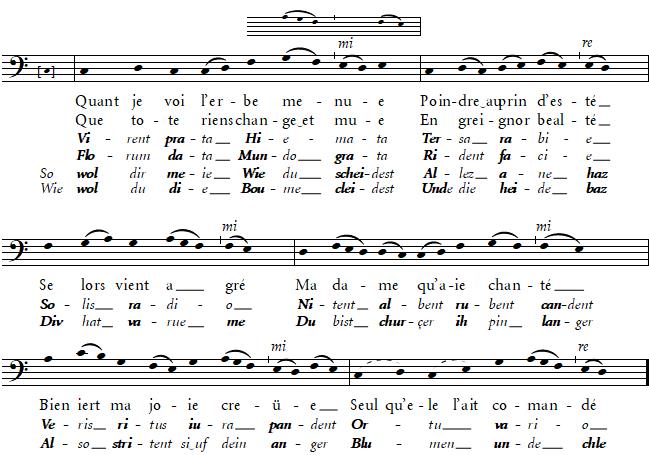Carmina Burana: ricerche sulla musica
Virent prata hiemata · Habet sidus leti visus
cb 151/169
testo
Fonti
B. München, Bayerischen Staatsbibliothek, Clm. 4660 (Carmina Burana), f. 61rv | f. 68r | ca 1230 — info
A. Heidelberg, Universitätsbibliothek, Cod. Pal. germ. 357, f. 38v | ca 1280 — info
M. Heidelberg, Universitätsbibliothek, Cod. Pal. germ. 848 (Codex Manesse), f. 132rv | text | 1300-40 — info
Contrafactum (?)
C. Bern, Stadtbibliothek, 389 [°C], f. 201v |
P. Paris, Bibliothèque Nationale, Français 20050 [Saint Germain, °U], f. 54rv | ca 1250 — info
Bibliografia
Legenda — Testo:  Edizione
Edizione  Riferimento | Musica:
Riferimento | Musica:  Edizione
Edizione  Riferimento
Riferimento
| B | A | M | C | P | |||
| Lachmann 1827 | #28] ed. di Walther (B dal 1843) |  |
 |
||||
| Brakelmann 1891 [1870] | i.27] | ||||||
| Gennrich 1932 | 248] ed. mensurale |  |
|||||
| Hilka-Schumann 1970 [1941] | ii. 256 | ii.285] ed. critica | ||||||
| Gennrich 1953 |  |
||||||
| Clemencic 1979 | 115, 196] ed. amensurata + commento |  |
|||||
| Linker 1979 | 154] #77.15 rif. bibl. |  |
 |
Testo
Interventi taciti: maiuscole, apostrofi e punteggiature resi secondo l’uso moderno; sciolte le forme tachigrafiche; adeguato l’uso di h; uniformata l’oscillazione ci/ti, f/ph, i/j/y, u/v; conservati i dittonghi semplici (ae/oe > e); semplificati i nessi mediolatini (mpn > mn); corrette scempiature, geminazioni ed errori non significativi.
| i. Virent prata | hiemata | tersa rabie, florum data | mundo grata | rident facie. solis radio | nitent, albent, rubent, candent, veris, ritus iura pandent | ortu vario. |
aab aab cd dc |
òoòo|òoòo|òoòoo òoòo|òoòo|òoòoo òoòoo|òoòoòoòo òoòoòoòo|òoòoo |
testo |
| ii. Aves dulci | melodia
| sonant garrule, omni via | voce pia | volant sedule, et in nemore | frondes, flores et odores sunt; ardescunt iuniores | hoc in tempore. |
|||
| v. So wol dir, meie, | wie du scheidest
| allez ane haz! wie wol du die | bovme cleidest | vnde die heide baz! div hat varue me. | «du bist churçer, ih pin langer!» also stritent si uf dein anger, | blůmen vnde chle. |
oòoòo|òoòo|òoòoò oooòo|òoòo|ò8òoò òoòoò|òoòoòoòo òoò8òoòo|òoòoò |
2. apparato
Contrafactum
| i. Quant je voi l'erbe menue | poindre al prin d'esté, que tote riens change et mue | en grignor bialté, se lors vient en gré | ma dame, qu'aie chanté, bien ert ma joie creüe, | puis qu'ele l'a comandé. |
ab ab bb ab |
oooòooòo|òoòoò oòooòoòo|ooòoò òoòoò|oòoòoò oòoòoò|oòoòoò |
testo |
Musica
Il contrafactum ipotizzato da Clemencic appare convincente (chiaramente derivato dalla casistica formale proposta da Gennrich 1932, che usa proprio questo brano). E' vero che l'ultimo verso francese è più lungo del latino, ma non è improbabile che il francese, ragionevolmente derivato, alla fine si sia preso una libertà. Apparentemente gli accenti interni del francese sembrerebbero preferire un passo ternario, ma il salto di terza che ripetutamente anticipa la quinta sillaba ne suggerisce un esecuzione accentata, cosa che induce alla binarietà anche il francese.

Esecuzioni
testo